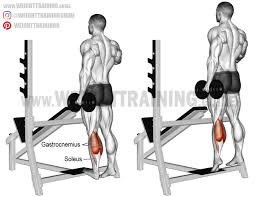Speed is your enemy on calf raises. The calf is made up of several muscles that work together each time you take a step—that's at least 5,000 reps per day for most of us. In order to improve size and strength in this area of your body, the mind-to-muscle connection is extremely important. I suggest using a 2-1-2-1 ratio: a two-second stretch, a one-second contraction up, a two-second isometric hold at the top of the range of motion, and then a two-second eccentric motion back down. Stacking five plates on a barbell and doing five max-out reps won't help you here!
Stand up (all the way up)
The calves are always going to be among the tougher muscle groups to develop. What a lot of people don’t know, though, is that seated calf raises really only activate the soleus—that is, the outer perimeter of your calves. Since your hamstrings are disengaged when you're seated, and since your leg muscles have such a close relationship with your gastrocnemius—the meaty part of your calf that makes you look good in shorts—the bulk of the calf doesn't get activated during a seated calf raise. Opt for the standing variety instead. —Josh Cox, Anytime Fitness
More steps mean more reps
Since they are already acclimated to the endurance loads associated with walking and running, the calves are much more capable of responding to high-volume sets than other body parts might be. Varying the number of repetitions during training will help keep you on your toes. (Sorry.) If you work your calves twice a week, do lighter sets of anywhere between 20 and 50 repetitions on one day, and on the other, try a few heavier sets closer to 10 reps
Boxes rock
If traditional calf raises aren't doing anything for you, try a set of box jumps in which you use only your calves to jump and land. (You obviously won't need a very high box for this.) Focus throughout on staying on your toes, both when your feet are on the floor and also when they're on the box. This is, incidentally, also a great way to incorporate a cardio element into your weight training.

